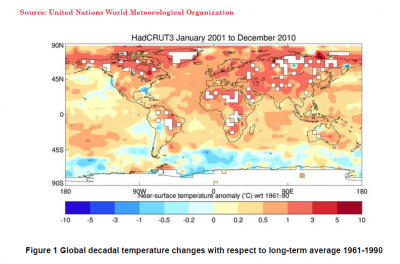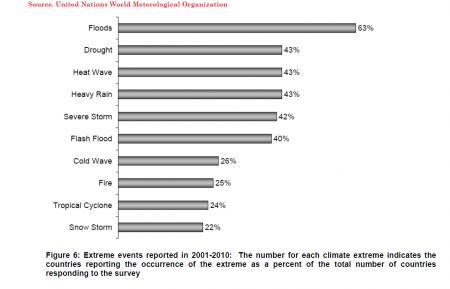“This 2011 annual assessment confirms the findings of the previous WMO annual statements that climate change is happening now and is not some distant future threat. The world is warming because of human activities and this is resulting in far-reaching and potentially irreversible impacts on our Earth, atmosphere and oceans.” --WMO Secretary-General Michel Jarraud
By Miriam Raftery
March 23, 2012 (Geneva) – The United Nation's World Meteorological Organization, representing 183 member nations, issued its Annual Statement onthe Status of the Global Climate today. The report concludes that climate change accelerated in the past decade and that 2011 was the 11th warmest year since records began in 1850.
Increasingly destructive tornadoes, floods and other indicators of global warming are also occuring with heightened frequency around the world. The new study found extreme weather events increased from 2001 to 2010 at an alarming rate consistent with global climate change. Worldwide, this included an increase in floods by 63%, drought 43%, heat waves 43%, heavy rain 43%, fires 25%, and tropical cyclones 24% among countries responding to the survey.
Globally-averaged temperatures in 2011 were estimated to be 0.40° Centigrade above the 1961-1990 annual average of 14°C.
 Precipitation extremes, many of them associated with one of the strongest La Niña events of the last 60 years, had major impacts on the world.
Precipitation extremes, many of them associated with one of the strongest La Niña events of the last 60 years, had major impacts on the world.
Significant flooding occurred on all continents, while major droughts affected parts of east Africa and North America.
Arctic sea ice extent fell to near record-low levels. Global tropical cyclone activity was below average, but the United States had one of its most destructive tornado seasons on record.
The annual statement for 2011 was released for World Meteorological Day 23 March. In addition, WMO also announced preliminary findings of the soon to be released Decadal Global Climate Summary, showing that climate change accelerated in 2001-2010, which was the warmest decade ever recorded in all continents of the globe.
The rate of increase since 1971 has been “remarkable” according to the preliminary assessment. Atmospheric and oceanic phenomena such as La Niña events had a temporary cooling influence in some years but did not halt the overriding warming trend.
The “dramatic and continuing sea ice decline in the Arctic” was one of the most prominent features of the changing state of the climate during the decade, according to the preliminary findings. Global average precipitation was the second highest since 1901 and flooding was reported as the most frequent extreme event, it said.
The full report will be released later in the year following further analysis of data received from National Meteorological and Hydrological Services and collaborating monitoring agencies. The decadal summary aims to increase understanding of our varying and changing climate from a longer-term perspective and complements WMO’s annual reports.
Highlights
Temperatures:
The decade 2001-2010 was the warmest since records began in 1850, with global land and sea surface temperatures estimated at 0.46°C above the long-term average (1961-1990) of 14.0°C. Nine of these years were among the ten warmest on record. The warmest year on record was 2010, closely followed by 2005, with a mean temperature estimated at 0.53°C above the long-term average. It was the warmest decade ever recorded for global land surface, sea surface and for every continent.
Most parts of Canada, Alaska, Greenland, Asia and northern Africa recorded temperatures for the decade between 1°C and 3°C above the 1961-1990 average.
Nearly 90% of the countries involved in the assessment experienced their warmest decade on record.
The global temperature increase rate has been “remarkable” during the previous four decades, according to the preliminary summary. The global temperature has increased since 1971 at an average estimated rate of 0.166°C per decade compared to the average rate of 0.06 °C per decade computed over the full period 1881-2010.
(See Figures 1-3)
Precipitation
Global precipitation (rain, snow etc) over land in 2001-2010 was the second highest average after 1951-60 since 1901. Within this global average, there were big regional and annual differences.
Large parts of the Northern Hemisphere recorded wetter-than-average conditions during the decade, especially the eastern United States of America, northern and eastern Canada, and many parts of Europe and central Asia. South America, including Colombia, parts of northern and southern Brazil, Uruguay and northeastern Argentina experienced wetter-than-average conditions, as did most parts of South Africa, Indonesia and northern Australia.
In contrast, other regions experienced, on average, below normal precipitation. The western United States, southwestern Canada, Alaska, most parts of southern and western Europe, most parts of southern Asia, central Africa, central South America, and eastern and southeastern Australia were the most affected.
(See Figures 4 and 5)
Extreme Events
Numerous weather and climate extremes affected almost every part of the globe with flooding, droughts, cyclones, heat waves, and cold waves. Two exceptional heat waves hit Europe and Russia during summer 2003 and 2010 respectively with disastrous impacts and thousands of deaths and outbreaks of prolonged bush fires.
Flooding was the most reported extreme event during the decade with many parts of the world affected. Historical widespread and prolonged flooding affected Eastern Europe in 2001 and 2005, Africa in 2008, Asia (in particular Pakistan) in 2010 and India in 2005, and Australia in 2010.
A large number of countries reported extreme drought conditions, including Australia, eastern Africa, the Amazonia region and the western United States. Humanitarian consequences were significant in eastern Africa during the first half of the decade, with widespread shortage of food and loss of lives and livestock.
Forty-eight out of 102 countries (47 per cent) reported that their highest national maximum temperature was recorded in 2001-2010, compared to 20 per cent for 1991-2000 and around 10 per cent for the earlier decades.
The decade saw the highest level of tropical cyclone activity on record for the North Atlantic basin. In 2005 category 5 hurricane Katrina was the most costly hurricane to hit the United States, with a significant human toll of more than 1 800 deaths. In 2008, tropical cyclone Nargis was the worst natural disaster in Myanmar and the world’s deadliest tropical cyclone during the decade, killing more than 70 000 people.
(See Figures 6 and 7)
Sea Ice
The decline in the Arctic sea-ice, observed since the end of the 1960s, continued throughout 2001-2010. A historical low Arctic sea-ice extent at the melting period in September was recorded in 2007.
Arctic sea ice extent was again well below average in 2011. The seasonal minimum, reached on 9 September, was 4.33 million square kilometres (35% below the 1979-2000 average) according to the U.S. National Snow and Ice Data Center. This was the second-lowest seasonal minimum on record, 0.16 million square kilometres above the record low set in 2007. Sea ice volume was even further below average and was estimated at a new record low of 4200 cubic kilometres, surpassing the record of 4580 cubic kilometres set in 2010.
Satellites have shown the fluctuation in sea ice from year to year since 1972. According to scientific measurements, both the thickness and sea ice extent in the Arctic have shown a marked decline over the past 35 years.
Data indicate, however, an even more dramatic reduction in Arctic sea ice cover in recent years. The last six years of the decade (2005 to 2010) recorded the lowest five September extents, with 2007 recording the record minimum extent with 4.28 million km2, 39 % below the 1979-2000 reference period.
The theme of World Meteorological Day 2012 is Powering the Future with Weather, Climate and Water. Full details of events and activities at
http://www.wmo.int/worldmetday/index_en.html
The WMO Statement on the Status of the Global Climate 2011 is available at
http://www.wmo.int/pages/prog/wcp/wcdmp/documents/1085_en.pdf







Comments
Global Warming Is an Unfortunate Fact of Life
Miriam has presented factual data that cannot any longer be denied. We all must find ways to live our lives by causing less carbon dioxide and other gases that make the greenhouse effect worsen. The way our society has been set up favors auto traffic; we've got to use more technology to overcome the need to travel to and from work. More home work and use of Skype and other video communications for online meetings would help a great deal. Let's take this notion to our boardrooms and make conscious efforts to be part of the solution, rather than continuing to ignore the problem.